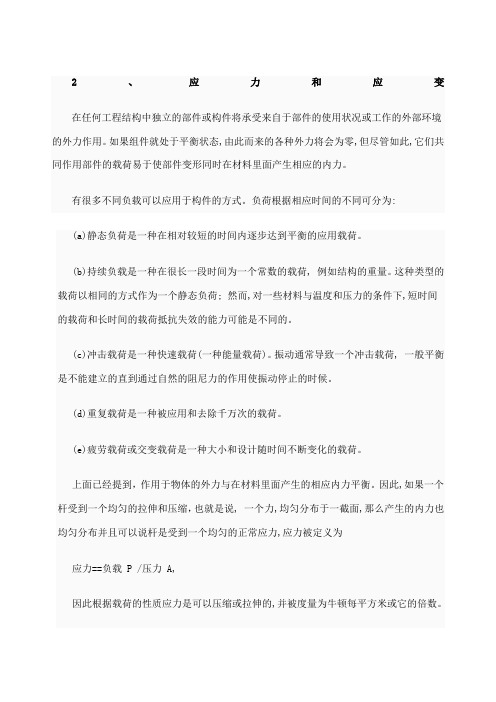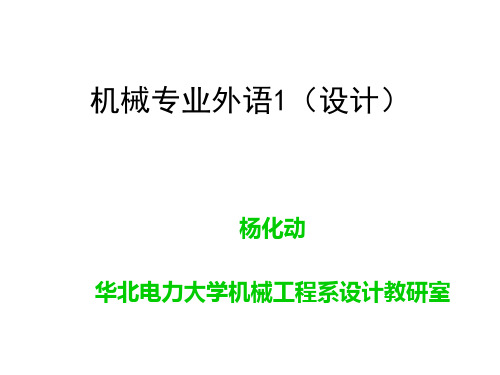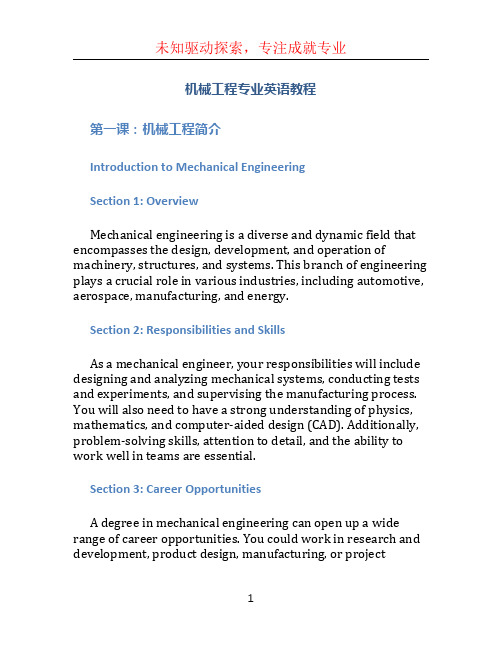机械工程专业英语唐一平翻译
(完整版)先进制造技术(英文版第三版)唐一平,第六章翻译

(完整版)先进制造技术(英文版第三版)唐一平,第六章翻译P836柔性制造作为生产系统的后续讨论介绍和先进的制造技术,它是目前定义的有用制造系统的概念。
制造系统可以被定义为一个增值的制造过程将原材料系列更为有用的形式和最终产品的11.)在现代制造环境中,灵活性是一个重要的特征.这意味着,一个制造系统是通用的和适应性,同时也有较高的生产能力。
柔性制造系统,可生产多种零件是通用的。
它适应性强,因为它可以迅速调整生产完全不同的零件。
柔性制造系统(FMS)是一个人机或组机器通过一个自动化材料处理系统服务计算机控制的具有工具处理能力。
因为它的工具能力和计算机控制处理,这样的系统可以不断地重新配置到各种各样的配件制造。
这就是为什么它被称为柔性制造系统。
柔性制造代表着完全的目标迈出的重要一步集成制造.它包括自动化生产一体化过程。
在柔性制造,自动化的制造机器(即,车床,铣,钻)和自动化材料处理系统之间通过计算机网络即时通信。
图为例柔性制造系统。
柔性制造向完全整合的目标迈出的重要一步由于集成了多种自动化制造概念制造:(1)计算机数值控制(CNC)个别机床。
(2)分布式数字控制(DNC)的制造系统。
(3)自动化材料处理系统。
P84(4)成组技术(家庭部分).当这些自动化流程,机器,和概念都带来了在一个完整的系统,就是所谓的柔性制造系统。
人类与电脑在FMS中扮演重要的角色。
人类的劳动量比少的多手工操作的制造系统,当然。
然而,人类仍然在柔性制造系统的运行起着至关重要的作用。
人类的工作包括下列各项:(1)设备的检修,维护,维修。
(2)更换和调整工具。
(3)装卸系统。
(4)数据输入。
(5)改变程序的部分.(6)发展计划.柔性制造系统设备,像所有的制造设备,P85必须检测错误,故障,故障。
一个问题是当发现,检修人员必须确定它的来源和使用纠正措施。
所有系统都正常运行时,周期维护是必要的。
人类的运营商也设置了机器,更换刀具,并重新配置系统是必要的。
机械工程专业英语唐一平翻译

Unit11.2Ferrous Metals and AlloysBy virtue of their wide range of mechanical, physical, and chemical properties, ferrous metals and alloys are among the most useful of all metals. Ferrous metals and alloys contain iron as their base metal: the general categories are cast irons, carbon and alloy steels, stainless steels, tool and die steels.1.2黑色金属及其合金:由于它们的一系列广泛的机械物理和化学的特征,黑色金属及其合金是所有金属中最有用的铁是黑色金属及其合金中的基本元素主要种类有铸铁,碳钢,合金钢,不锈钢,工具钢和磨具钢The term cast iron refers to a family of ferrous alloys composed of iron, carbon(ranging from 2.11% to about 4.5%),and silicon(up to about 3.5%).Cast irons are usually classified as follows:Gray cast iron,or gray iron;Ductile cast iron, nodular cast iron, or spherical graphite cast iron;White cast iron;Malleable iron;Compacted graphite iron。
(),它包含铁碳(2.5%—4.5%)和硅( 3.5%)铸铁的分类如下1.灰铸铁 2.球墨铸铁3.白口铸铁4.可锻铸铁5.如墨铸铁The equilibrium phase diagram relevant to cast irons is shown in Fig.1.1,in which the right boundary is 100% carbon,that is pure graphite.The eutectic temperature is 1154hC (2109hF), and so cast irons are completely liquid at temperatures lower than those required for liquid steels. Consequently, iron with high carbon content can be cast at lower temperatures than can steels.有关铸铁的平衡相图如图1.1所示其右边界是100%的碳那是纯石墨,其共晶温度是1154℃因此铸铁可以在比那些熔化钢更低的温度下完全液化所以含碳量较高的铸铁的浇注温度比钢低。
机械工程专业英语原文翻译 哈工版

2、应力和应变在任何工程结构中独立的部件或构件将承受来自于部件的使用状况或工作的外部环境的外力作用。
如果组件就处于平衡状态,由此而来的各种外力将会为零,但尽管如此,它们共同作用部件的载荷易于使部件变形同时在材料里面产生相应的内力。
有很多不同负载可以应用于构件的方式。
负荷根据相应时间的不同可分为:(a)静态负荷是一种在相对较短的时间内逐步达到平衡的应用载荷。
(b)持续负载是一种在很长一段时间为一个常数的载荷, 例如结构的重量。
这种类型的载荷以相同的方式作为一个静态负荷; 然而,对一些材料与温度和压力的条件下,短时间的载荷和长时间的载荷抵抗失效的能力可能是不同的。
(c)冲击载荷是一种快速载荷(一种能量载荷)。
振动通常导致一个冲击载荷, 一般平衡是不能建立的直到通过自然的阻尼力的作用使振动停止的时候。
(d)重复载荷是一种被应用和去除千万次的载荷。
(e)疲劳载荷或交变载荷是一种大小和设计随时间不断变化的载荷。
上面已经提到,作用于物体的外力与在材料里面产生的相应内力平衡。
因此,如果一个杆受到一个均匀的拉伸和压缩,也就是说, 一个力,均匀分布于一截面,那么产生的内力也均匀分布并且可以说杆是受到一个均匀的正常应力,应力被定义为应力==负载 P /压力 A,因此根据载荷的性质应力是可以压缩或拉伸的,并被度量为牛顿每平方米或它的倍数。
如果一个杆受到轴向载荷,即是应力,那么杆的长度会改变。
如果杆的初始长度L和改变量△L已知,产生的应力定义如下:应力==改变长△L /初始长 L因此应力是一个测量材料变形和无量纲的物理量 ,即它没有单位;它只是两个相同单位的物理量的比值。
一般来说,在实践中,在荷载作用下材料的延伸是非常小的, 测量的应力以*10-6的形式是方便的, 即微应变, 使用的符号也相应成为ue。
从某种意义上说,拉伸应力与应变被认为是正的。
压缩应力与应变被认为是负的。
因此负应力使长度减小。
当负载移除时,如果材料回复到初始的,无负载时的尺寸时,我们就说它是具有弹性的。
(完整)先进制造技术(英文版第三版)唐一平,第五章翻译

P655数控数控(NC)是一种控制运动的方法通过直接插入代码指令的机器部件,以数字和字母,进入系统.系统自动解释这些数据并将其转换成输出信号。
这些信号,反过来,控制各种例如机器的部件,通过旋转主轴和关闭,改变工具,移动工件或工具沿着特定路径,或转向切削液的开和关.为了感谢机床数字控制的重要性,让我们简要回顾一个过程如何如工历来是开展。
在研究一部分的工作图纸,操作员设置合适的工艺参数(如切削速度,切削深度进给,切削液,等等),确定加工操作顺序要执行,夹在工件夹具的工件(如卡盘或夹头),并与部分的收益。
根据零件的形状和规定的尺寸精度,这方法需要熟练的操作人员。
后面的加工过程可能依赖于特定的操作;由于人类的可能性错误,甚至部分由同一操作者产生可能不完全相同。
零件的质量,因此,依赖于特定的操作或(甚至同一运营商)在一周或一天的时间一天。
因为增加关注提高产品质量和降低制造成本,这种变异(和对产品质量的影响)不再可接受的。
这种情况可以通过数值控制消除加工操作。
数值控制的重要性可以通过进一步的说明下面的例子。
假设几个孔被钻的一部分图5所示位置。
1.P66在加工这部分传统手工方法,操作者位置钻头相对于工件,使用参考点通过三种方法显示在图中给出。
然后操作员进行钻孔.让我们先假设100个部分,都有形状和尺寸精度的同时,也要钻。
显然,这操作将是乏味的,因为操作者必须经过相同的动作反复。
此外,概率高,各种原因,一些零件加工将与众不同。
现在让我们假设这个生产运行过程中,这些组成部分的顺序是改变了,和十的部分现在需要不同位置的孔.的机械师现在必须重新定位工作台;此操作将时间消费是错误的。
这样的操作可以由数控机床很容易进行能够生产部分多次准确地处理不同的部分(通过加载不同的部分程序,将描述后).在数值控制操作下,有关的所有方面的数据加工操作,如位置,速度,饲料,和切削液,可以存储在磁性介质上,随着时间变化从磁带到硬盘.的数控控制概念,具体信息可以向这些存储设备到机床的控制面板。
机械工程专业英语翻译

机械工程专业英语翻译Introduction机械工程是一门涵盖机械原理、设计、制造以及维护的综合性学科,其中涉及许多专业术语和英语翻译。
良好的英语翻译能力对机械工程师在国际合作和成果交流中至关重要。
本文将介绍机械工程专业中常见的英语单词和短语,并提供中文翻译和相关注释。
Mechanical Principles 机械原理对于机械原理,下面是一些常见的英语单词和短语。
1.Mechanism(机构):A mechanism is a device designedto transform input forces and movement into a desiredoutput force and movement.2.Kinematics(运动学):Kinematics is the study ofmotion, without regard to the cause of the motion.3.Statics(静力学):Statics is the study of thebehavior of structures, under the action of forceswithout producing motion.4.Dynamics(动力学):Dynamics is the study of thebehavior of motion of objects under the action of forces.5.Thermodynamics(热力学):Thermodynamics deals withthe relationships between heat, work, and energy.6.Fluid Mechanics(流体力学):Fluid mechanics is thestudy of the behavior of fluids at rest or in motion. Mechanical Design 机械设计对于机械设计,下面是一些常见的英语单词和短语。
机械工程专业英语课本翻译

Paragraph 4
• The austenitic stainless steels have the austenite structure retained at room temperature. • 奥氏体不锈钢在室温保留奥氏体结构。 • The austenite has the fcc structure and is stable above 910℃. • 奥氏体有面心立方结构, 910℃以上处于稳定状 态。 • This structure can occur at room temperature when it is stabilized by an appropriate alloy addition such as nickel. • 通过添加诸如镍等恰当的合金,这一结构能够在 室温下形成。
• •
•
• •
二、晶胞原子数:1/8×8+1/2×6=4(个)
三、原子半径:γ原子=四分之根号三a 四、致密度:0.74(74%)
体心立方晶格
• 体心立方晶格的晶胞中,八个原子处于立方体的角上,一个原子 处于立方体的中心,角上八个原子与中心原子紧靠。具有体心立方晶 格的金属有钾(K)、钛(Ti)、钼(Mo)、钨(W)、钒(V)、α铁(α-Fe,<912℃)等。 单位晶胞原子数为2
• Low carbon steel containing from 0.02 to 0.25 percent carbon, and they are very soft and can be used for bolts and for machine parts that do not need strength.
淬火
•
钢的淬火是将钢加热到临界温度Ac3(亚共析钢) 或Ac1(过共析钢)以上某一温度,保温一段时间, 使之全部或部分奥氏体[1]化,然后以大于临界冷却 速度的冷速快冷到Ms以下(或Ms附近等温)进行马氏 体(或贝氏体)转变的热处理工艺。 淬火的目的是使过冷奥氏体进行马氏体或贝氏体 转变,得到马氏体或贝氏体组织,然后配合以不同温 度的回火,以大幅提高钢的强度、硬度、耐磨性、疲 劳强度以及韧性等,从而满足各种机械零件和工具的 不同使用要求。也可以通过淬火满足某些特种钢材的 的铁磁性、耐蚀性等特殊的物理、化学性能。 淬火能使钢强化的根本原因是相变,即奥氏体组 织通过相变而成为马氏体组织(或贝氏体组织)。
机械工程专业英语教程课文翻译[整理版]
![机械工程专业英语教程课文翻译[整理版]](https://img.taocdn.com/s3/m/92f7af11e97101f69e3143323968011ca300f799.png)
第三课Overview of Engineering Mechanics工程力学概述当我们观察我们周围就会发现世界充满“物品”:机器,设备,工具;我们已经设计,建造,并使用的物品;木头,金属,陶瓷和塑料制品。
根据我们使用的经验知道,有些物品比其它物品更好;他们使用寿命较长,费用较低,噪音更低,更好看,或者更方便我们使用。
然而,在理想的情况下,每一件产品都是设计人员工具其对某些“功能要求”的理解而设计出来的,也就是说,在设计过程中,应该回答这样的问题,即“它应该具有哪种确切的功能?”在工程领域,主要功能通常是承受由于重力,惯性力,压力等作用的一些类型的载荷。
从我们居住房屋的梁到飞机机翼,都必须有一个适当的材料,尺寸,在较合理的寿命基础上具有较合理的成本并能可靠地完成其功能的产品结构连接的组合。
在实践中,工程力学方法常被应用在两个完全不同领域:(1) 任何新装置的研发都需要对其结构,尺寸,材料,载荷,耐久性,安全和成本的反复考虑。
(2) 当一个装置(意外地)发生失效后,通常需要进行研究,找出失效的原因,并找出潜在的纠正措施。
最好的设计往往都是不断排除薄弱环节的演变过程。
对许多工程师来说,上述过程既可以令人非常的陶醉又可以使人非常的愉快,更何况(有时)对我们是有利的。
对于任何实际的问题,总是缺乏足够完整和有用的信息。
我们很少准确地知道实际荷载和工作状态,因此,所做的分析工作也很少是精确的。
虽然我们的数学可以准确,全面的分析一般只能近似,而且不同技术水平的人能得到不同的解。
在工程力学研究领域,大多数问题要想得到唯一解就要充分的理想化,但应该清楚,“现实世界”远不非理想化程度,因此为了得到问题的解决方案不得不进行一些理想化假设。
我们要考虑的技术领域通常被称为“静力学”和“材料力学”,“静力学”,指的是研究作用在固定装置上的作用力,“材料力学”指的是施加到结构的力(变形,载荷限制等)的影响。
但是,事实上很多设备都不是静态的,如果与动力学有关的额外负荷被考虑了的话,那么静力学的研究方法完全适用于动态的情况,只要动态力相对静态载荷较小,系统通常被认为是静态的。
《机械工程专业英语教程》课文翻译

机械工程专业英语教程第一课:机械工程简介Introduction to Mechanical EngineeringSection 1: OverviewMechanical engineering is a diverse and dynamic field that encompasses the design, development, and operation of machinery, structures, and systems. This branch of engineering plays a crucial role in various industries, including automotive, aerospace, manufacturing, and energy.Section 2: Responsibilities and SkillsAs a mechanical engineer, your responsibilities will include designing and analyzing mechanical systems, conducting tests and experiments, and supervising the manufacturing process. You will also need to have a strong understanding of physics, mathematics, and computer-aided design (CAD). Additionally, problem-solving skills, attention to detail, and the ability to work well in teams are essential.Section 3: Career OpportunitiesA degree in mechanical engineering can open up a wide range of career opportunities. You could work in research and development, product design, manufacturing, or projectmanagement. Mechanical engineers are in demand in almost every industry, ensuring a stable and rewarding career path.Section 4: University CoursesTo become a mechanical engineer, it is essential to pursue a degree in mechanical engineering from a reputable university. The curriculum typically includes courses in engineering principles, materials science, thermodynamics, fluid mechanics, and mechanical design. Additionally, practical training through internships or cooperative education programs is crucial for gaining hands-on experience.Section 5: ConclusionMechanical engineering offers a challenging and rewarding career for those with a passion for solving problems and a desire to create innovative solutions. With the right education and skills, you can embark on a successful journey in the field of mechanical engineering. Remember, the possibilities are endless in this ever-evolving discipline.第二课:机械设计基础Fundamentals of Mechanical DesignSection 1: IntroductionIn this lesson, we will explore the fundamentals of mechanical design. Mechanical design involves the creation and development of physical systems and components that meet specific requirements and specifications. This processrequires a deep understanding of materials, mechanics, and engineering principles.Section 2: Design ProcessThe design process typically follows a systematic approach that includes several stages. These stages include problem identification, conceptual design, detailed design, manufacturing, and testing. Each stage involves various activities such as brainstorming, prototyping, and evaluation.Section 3: Design ConsiderationsDuring the design process, there are several important considerations to keep in mind. These include functionality, efficiency, reliability, safety, and cost-effectiveness. It is also crucial to consider the environmental impact and sustainability of the design.Section 4: Tools and SoftwareTo aid in the design process, engineers use various tools and software. Computer-aided design (CAD) software allows for precise modeling and simulation of mechanical systems. Finite element analysis (FEA) software helps in analyzing the structural integrity and performance of designs.Section 5: Case StudyTo further understand the application of mechanical design principles, we will examine a case study. This real-world example will demonstrate how the design process isimplemented to solve a specific problem and achieve desired outcomes.Section 6: ConclusionMechanical design is a critical aspect of mechanical engineering. It requires a combination of creativity, technical knowledge, and attention to detail. By mastering the fundamentals of mechanical design, you will be well-equippedto tackle complex challenges and contribute to the development of innovative solutions.以上是《机械工程专业英语教程》的课文翻译。
- 1、下载文档前请自行甄别文档内容的完整性,平台不提供额外的编辑、内容补充、找答案等附加服务。
- 2、"仅部分预览"的文档,不可在线预览部分如存在完整性等问题,可反馈申请退款(可完整预览的文档不适用该条件!)。
- 3、如文档侵犯您的权益,请联系客服反馈,我们会尽快为您处理(人工客服工作时间:9:00-18:30)。
Unit11.2Ferrous Metals and AlloysBy virtue of their wide range of mechanical, physical, and chemical properties, ferrous metals and alloys are among the most useful of all metals. Ferrous metals and alloys contain iron as their base metal: the general categories are cast irons, carbon and alloy steels, stainless steels, tool and die steels.1.2黑色金属及其合金:由于它们的一系列广泛的机械物理和化学的特征,黑色金属及其合金是所有金属中最有用的铁是黑色金属及其合金中的基本元素主要种类有铸铁,碳钢,合金钢,不锈钢,工具钢和磨具钢The term cast iron refers to a family of ferrous alloys composed of iron, carbon(ranging from 2.11% to about 4.5%),and silicon(up to about 3.5%).Cast irons are usually classified as follows:Gray cast iron,or gray iron;Ductile cast iron, nodular cast iron, or spherical graphite cast iron;White cast iron;Malleable iron;Compacted graphite iron。
(),它包含铁碳(2.5%—4.5%)和硅( 3.5%)铸铁的分类如下1.灰铸铁 2.球墨铸铁3.白口铸铁4.可锻铸铁5.如墨铸铁The equilibrium phase diagram relevant to cast irons is shown in Fig.1.1,in which the right boundary is 100% carbon,that is pure graphite.The eutectic temperature is 1154hC (2109hF), and so cast irons are completely liquid at temperatures lower than those required for liquid steels. Consequently, iron with high carbon content can be cast at lower temperatures than can steels.有关铸铁的平衡相图如图1.1所示其右边界是100%的碳那是纯石墨,其共晶温度是1154℃因此铸铁可以在比那些熔化钢更低的温度下完全液化所以含碳量较高的铸铁的浇注温度比钢低。
Carbon steels are generally classified by their proportion(by weight) of carbon content.1.Low-carbon steel, also called mild steel, has less than 1.30% carbon. It is generally used for common industrial products, such as bolts,nuts, sheet, plate, and tubes, and for machine components that do not require high strength.碳钢:碳铜大体上是按碳含量的臂力来分类的低碳钢又叫做软钢其碳含量小于0.30%它用于普遍的工业产品,例如螺栓,螺母。
钢板,港片钢管和那些强度要求不高的机器零件Unit55.1 IntroductionConventional machining is the group of machining operations that use single- or multi-point tools to remove material in the form of chips.Metal cutting involves removing metal through machining operations.Machining traditionally takes place on lathes, drill presses, and milling machines with the use of various cutting tools.Most machining has very low set-up cost compared with forming, molding, and casting processes.However, machining is much more expensive for high volumes.Machining is necessary where tight tolerances on dimensions and finishes are required.传统机加工是利用单刃或多刃刀具以切削形式去除材料的(一组)加工方法。
金属切削就是利用机加工的方法去除材料,传统机加工都是利用不用的刀具在车床,钻床和铣床上进行的,与成型加工,模压制件和铸造工艺相比,机加工的准备成本还是比较低的。
然而,如果是大批量生产,其成本要高得多,当对零件的光洁度和尺寸公差要求较高时,机加工是必须的。
5.2 Turning and LatheTurning is one of the most common of metal cutting operations. In turning, a workpiece is rotated about its axis as single-point cutting tools are fed into it, shearing away excess material and creating the desired cylindrical surface. Turning can occur on both external and internal surfaces to produce an axially-symmetrical contoured part.Parts ranging from pocket watch components to large diameter marine propeller shafts can be turned on a lathe.车削与车床车削是金属切削加工中最常用的方法之一。
在车削过程中,一个工件绕其轴线回转,单刃车刀沿工件进给,切掉多余的材料,最后形成要求的圆柱型表面,车削可以加工外表面以形成轴对称的成型零件,从怀表的零件到大型螺旋角零件轴都可以在车床上加工。
Apart from turning, several other operations can also be performed on a lathe.除了车削,一些其它的操作也可以在车床上完成。
Boring and internal turning. Boring and internal turning are performed on the internal surfaces by a boring bar or suitable internal cutting tools. If the initial workpiece is solid, a drilling operation must be performed first. The drilling tool is held in the tailstock, and the latter is then fed against the workpiece. When boring is done in a lathe, the work usually is held in a chuck or on a face plate. Holes may be bored straight, tapered, or to irregular contours. Boring is essentially internal turning while feeding the tool parallel to the rotation axis of the workpiece.镗削和车内圆:利用镗杆或合适的内圆车刀可以进行镗削和车内圆。
工件毛坯如果是实心的,首先要钻孔,钻头安装在尾架上,后者向工件进给,如果在车床上进行镗削,工件一般安装在卡盘活花盘上。
镗出的孔可以是盲孔、锥孔或者不规则的轮廓,当工具与回转轴平行进给时,镗削实际上是车削。
Unit7Quality and accuracy are major considerations in making parts or structures. Interchangeable parts require a high degree of accuracy to fit together. With increasing accuracy or less variation in the dimension, the labor and machinery required to manufacture apart is more cost intensive. Any manufacturer should have a thorough knowledge of the tolerances to increase the quality and reliability of a manufactured part with the least expense.在制造机器零件和结构的过程中,质量和精度是最重要的因素。
互换性零件需要有高精度以实现相互配合。
随着精度的增加和尺寸变化的减小,制造零件所需的劳动力和机器更趋于成本密集型,制造商应该对公差有全面的了解,并以最小的成本提高加工零件的质量和可靠性。
